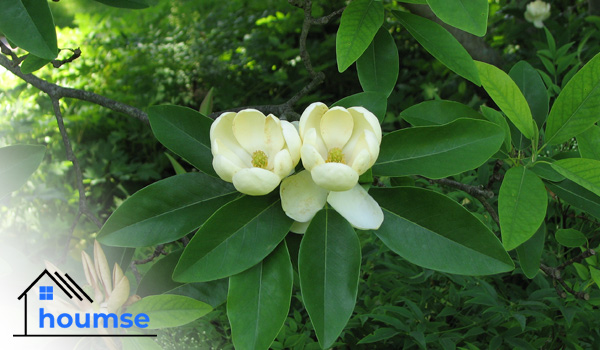Top 15 Types of Magnolia Trees for Your Garden

A pink magnolia tree is one of the most gorgeous species that nature has to offer. However, one can say the same thing about other types of magnolia trees as well.
Ranging from large trees to more compact shrubs, slow growers to the ones that mature more quickly, evergreen to deciduous, a magnolia tree in bloom creates an impressive focal point blessed with (often) fragrant flowers.
Whether you are looking forward to introducing a pink magnolia tree to your garden or thinking about adding other types to your collection, here are the 15 best types of magnolia trees for any location and situation.
Types of Magnolia Trees
Named after Pierre Magnol, this French botanist transplanted this tree to Europe 300 years ago. However, the magnolia tree is actually an ancient genus dating back over 20 million years ago.
Since that means they existed before bees, they evolved in a way to encourage pollination by beetles. Later, they evolved and allow pollination by bees as well. Most of these trees are deciduous, but some have evolved into evergreens and semi-evergreens; another reason that makes a pink magnolia tree excellent for screening. Some types of magnolia trees even change their growing habits depending on their environment.
As you are going to see below, there is no specific pink magnolia tree. In addition to pink, there are also some types that display their star-shaped flowers in shades of white, purple, and even yellow for those who want to mix things up. Without producing nectar (rather pollen), these blooms dissipate a sweet scent that attracts pollinators like bees.
Without further a due, here are some of the most common and beautiful magnolia tree types:
Saucer Magnolia Tree
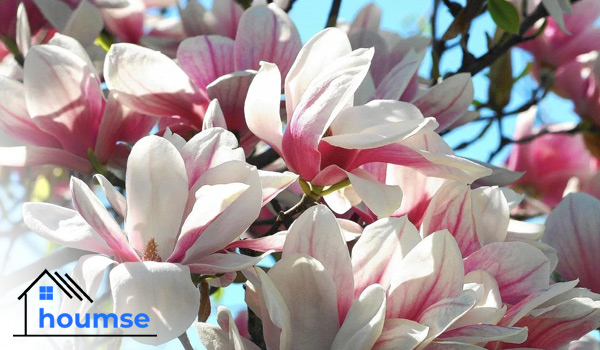
- Bloom Shade: Wide-spread large shrub or small tree
- Mature Shape: Majorly pink, plus white and purple
- Mature Size: 10 to 40 feet tall, 4 to 45 feet wide
- Hardiness: 4 to 9
- Light: Full sun to partial shade
- Soil: Well-drained and moist acidic, loamy, sandy, and clay soils
Also known as the magnolia soulangeana tree and pink magnolia tree, this specimen produces the most spectacular flowers in late winter and early spring. The fragrant flowers are white with a beautiful shade of light to deep pink or purplish pink.
Other varieties of the pink magnolia tree have lovely colors as well; the ‘Alexandrina’ has blooms that are pale pink at the tips and darker at the base, while the smaller ‘Lennei’ looks deep pink outside, but it is completely white inside.
The saucer magnolia tree grows upright when young. But, while maturing, it branches repeatedly and turns into a small, widely spreading shrub. When mature, in addition to the blooms, you can enjoy its attractive grey bark too.
Galaxy Magnolia Tree
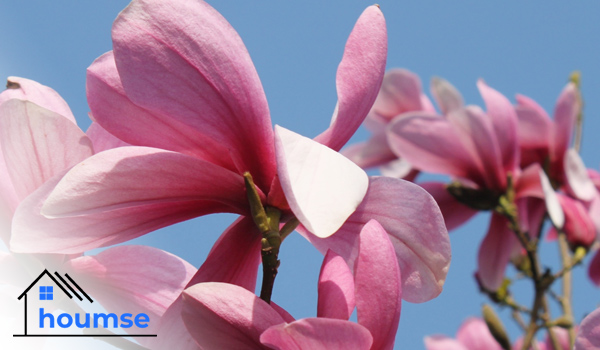
- Bloom Shade: Small, single-stemmed tree
- Mature Shape: Pink purple to reddish-purple
- Mature Size: 25 to 30 feet tall, 20 to 25 feet wide
- Hardiness: 4 to 8
- Light: Full sun to partial shade
- Soil: Well-drained and moist acidic, loamy, sandy, and clay soils
For those who prefer a pinker magnolia tree, this variety develops pink-purple buds to reddish-purple ones that have a lighter color inside. They have a light scent and open mid-spring.
Galaxy magnolia tree leaves have the conventional small, leathery appearance and will not hide the glow of the flowers. This type is a fast grower, turning into an elegant tree with a single stem and broadening out as maturing.
If amazing flower, quick maturing and flowering even when young is not enough to grow this species, remember that the ‘Galaxy’ handles poor soils and generally has easier care compared to other pink magnolia trees.
Betty Magnolia Tree
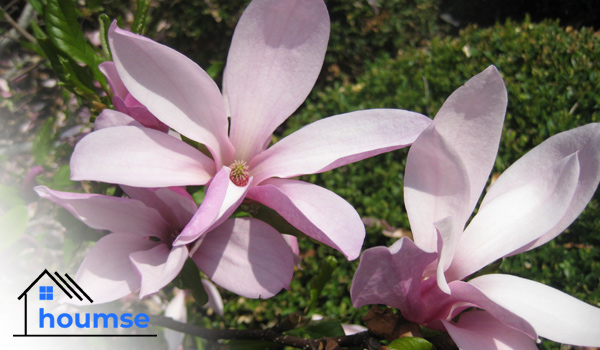
- Bloom Shade: White, pinkish-purple
- Mature Shape: Large shrub or small multi-stemmed tree
- Mature Size: 10 to 15 feet tall, 15 to 20 feet wide
- Hardiness: 4 to 7
- Light: Full sun to partial shade
- Soil: Well-drained and moist acidic, loamy, sandy, and clay soils
‘Betty’ can both be a dwarf pink magnolia tree with multiple stems or a round spreading shrub in your garden. It has flowers that are white on the inside with a light pink base. On the outside, you can see the pinkish-purple shade becoming deeper on the tips.
These large blooms have about 20 petals and open to 8 to 10 inches a little later than other types of magnolia trees. That means they will not frost. If you are living in a cold climate, this hardy tree is perfect for you.
Southern Magnolia Tree
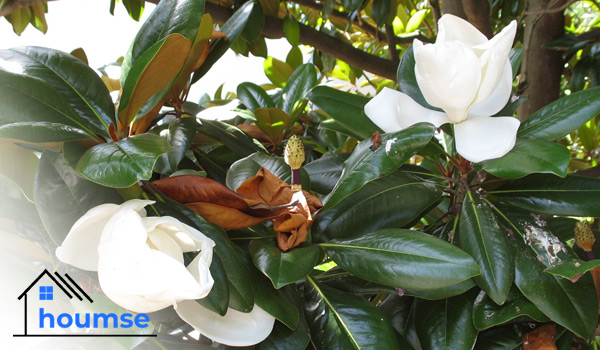
- Bloom Shade: Creamy White
- Mature Shape: Single-stemmed tree
- Mature Size: 60 to 80 feet tall, 20 to 40 feet wide
- Hardiness: 6 to 10
- Light: Full sun to partial shade
- Soil: Well-drained and moist acidic, loamy, sandy, and clay soils
Although not a pink magnolia tree, this is one of the most common varieties. Botanically known as Magnolia grandiflora, this evergreen variety is mostly known for its large, white flowers with strong fragrance in late spring and early summer.
Broad Southern magnolia tree leaves are broad, deep green, and shiny, creating an eye-catching contrast with the creamy blooms.
Caerhays Belle Magnolia Tree
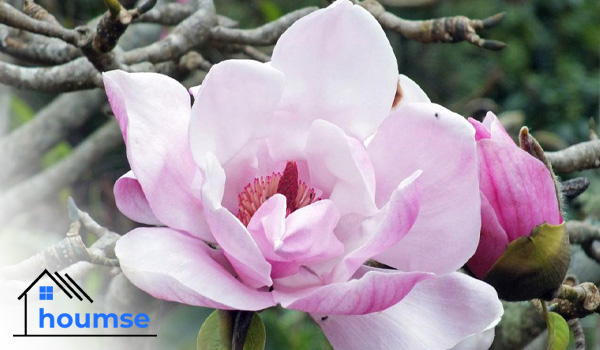
- Bloom Shade: White, pink
- Mature Shape: Upright or pyramid-shaped tree
- Mature Size: 20 to 40 feet
- Hardiness: 6 to 9
- Light: Full sun to partial shade
- Soil: Well-drained and moist acidic, loamy, sandy, and clay soils
This pink flowering magnolia tree has a small to medium size growing upright or pyramid-shaped. So, if you prefer growing a variety that spreads while maturing, try other types of magnolia trees.
In early spring, the fascinating blooms appear and reach about 12 inches across. They are pure white on the inside and salmon pink on the outside with dark lines.
This magnolia tree in bloom creates an unbelievable view, as its flowers face slightly outwards and not simply upwards. By fall, the buds have turned into long, nobly, pink fruits.
Anise Magnolia (Willow Leaf Magnolia)
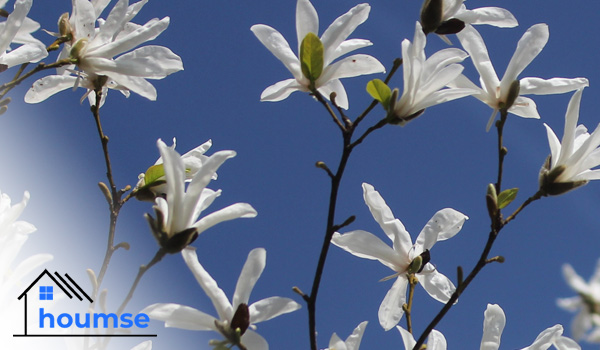
- Bloom Shade: White, golden yellow
- Mature Shape: Medium-sized tree
- Mature Size: 20 to 30 feet
- Hardiness: 6 to 9
- Light: Full sun to part shade
- Soil: Well-drained and moist acidic, loamy, sandy, and clay soils
Scientifically known as the Magnolia salicifolia, this deciduous tree produces white flowers with strappy petals in the spring, turning golden yellow in color when fall arrives.
Anise magnolia leaves are still closed when the showy blooms open. After unfurling, they resemble a wider version of a willow tree or shrub leaves, but not as wide as the usual magnolia tree leaves.
Daybreak Magnolia Tree
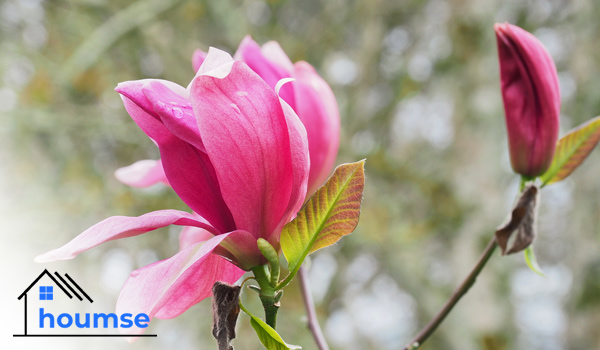
- Bloom Shade: Rose pink
- Mature Shape: Columnar, upright tree
- Mature Size: 20 to 25 feet tall, 3.5 to 8 feet wide
- Hardiness: 5 to 8
- Light: Full sun to part shade
- Soil: Well-drained and moist acidic, loamy, sandy, and clay soils
This favored pink magnolia tree with the upright growth pattern and moderate size make the perfect backyard/garden tree. This is a deciduous and fastigiate tree, meaning that it features upright branches close growing together.
‘Daybreak’ buds are green at first but turn into rosy-pink flowers in mid-spring, reaching 9 to 10 inches across. The blooms are paler on the inside and emit an incredibly strong scent when fully open.
The good news is that, unlike many other types, even when young, you can enjoy these flowers among medium ‘Daybreak’ magnolia tree leaves.
Star Magnolia Tree
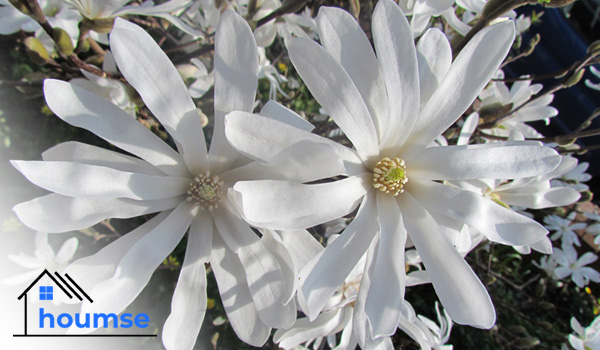
- Bloom Shade: White
- Mature Shape: Small tree or a large shrub
- Mature Size: 15 to 20 feet tall, 10 to 15 feet wide
- Hardiness: 4 to 9
- Light: Full sun to part shade
- Soil: Well-drained and moist acidic, loamy, sandy, and clay soils
Also known as Magnolia stellata, this plant is a hardy variety with moderate flooding and drought tolerance. ‘Star’ also offers a charming contrast among white blooms, gray bark, and dark green magnolia leaves. You can grow this deciduous specie as a small tree or a large shrub.
Bigleaf Magnolia Tree
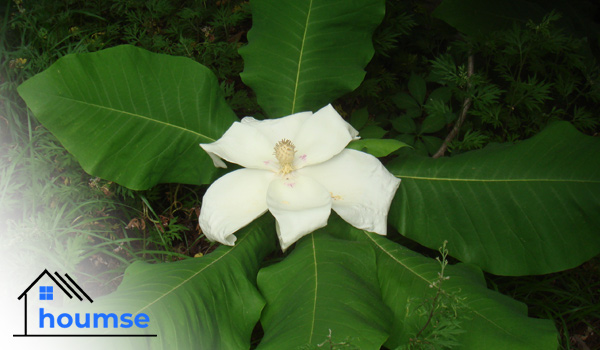
- Bloom Shade: Creamy white, purple
- Mature Shape: Small tree
- Mature Size: 30 to 20 feet tall, 10 to 15 feet wide
- Hardiness: 5 to 8
- Light: Full sun to part shade
- Soil: Well-drained and moist acidic, loamy, sandy, and clay soils
As the name suggests, Bigleaf magnolia tree leaves (M. marophylla) are truly huge, growing more than 30 inches long. This deciduous come from Mexico. So, you may consider it evergreen in warm zones.
The showy blossoms appear in mid-spring and display white petals with purple bases. They are as much as 10 inches across and capture the attention instantly among large magnolia leaves.
Leonard Messel Magnolia
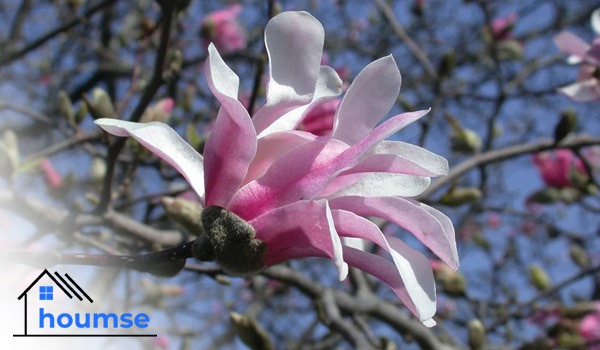
- Bloom Shade: Pale pink, pink
- Mature Shape: Large shrub
- Mature Size: 15 to 30 feet tall, 20 to 25 feet wide
- Hardiness: 5 to 9
- Light: Full sun to part shade
- Soil: Well-drained and moist acidic, loamy, sandy, and clay soils
This pink magnolia tree is closer to a shrub and takes on a dome-shaped as it ages. Among types of magnolia trees, this heavenly species displays its deep lilac-pink flowers that are about 5 inches in diameter.
These fragrant are frost-resistant and dissipate a sweet aroma as well. Overall, this type offers one of the most beautiful blossoms in this genus.
Kobus Magnolia
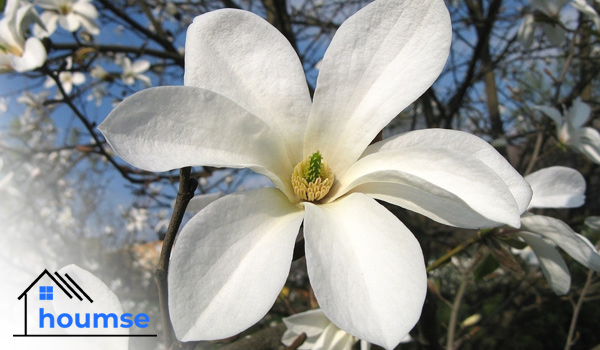
- Bloom Shade: White
- Mature Shape: Spreading tree
- Mature Size: 25 to 30 feet tall, 35 feet wide
- Hardiness: 5 to 8
- Light: Full sun to part shade
- Soil: Well-drained and moist acidic, loamy, sandy, and clay soils
This tree creates a focal point like no other variety! When young, ‘Kobus’ is pyramidal. But, as it ages, it becomes notably spreading, dense, and rounded. It also handles some flooding and moderate drought very well.
Throughout late winter to early spring, you can enjoy the white (often pink-tinged) flowers and their pleasant fragrance.
Cucumber Tree Magnolia
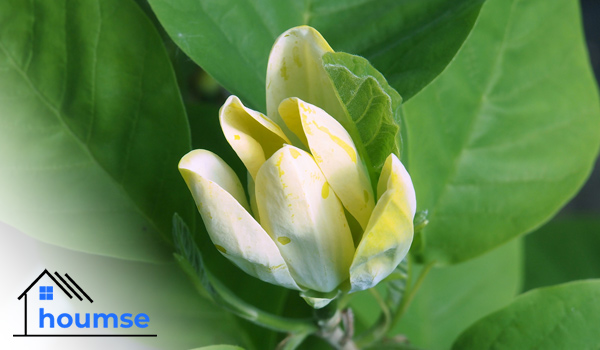
- Bloom Shade: Greenish
- Mature Shape: Large tree
- Mature Size: 60 to 75 feet tall
- Hardiness: 3 to 8
- Light: Full sun to part shade
- Soil: Well-drained and moist acidic, loamy, sandy, and clay soils
Magnolia acuminata inherits its common name from the shape of its fruits, which are quite similar to that vegetable. The green and later red fruits follow the yellow-green, small (2 inches), tulip-like flowers.
Although the flowers are not as showy as other varieties, the acuminata magnolia tree leaves are large (6 to 10 inches long) with a glossy finish. The leaves are indeed charming, but they can make a mess in the garden.
Compared to other magnolia tree types, this is one of the largest and the most cold-hardy species perfect as a shade tree.
Jane Magnolia Tree
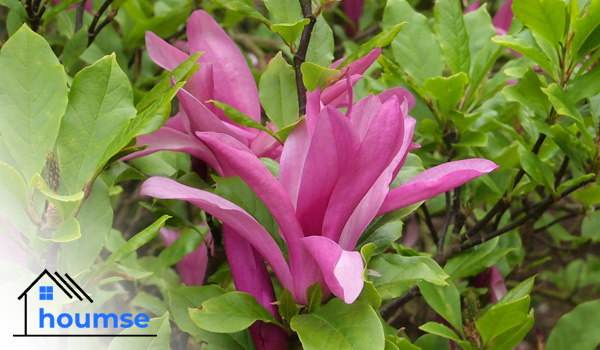
- Bloom Shade: Pink, reddish-purple
- Mature Shape: Large shrub or a small tree
- Mature Size: 10 to 15 feet tall, 8 to 12 feet wide
- Hardiness: 4 to 7
- Light: Full sun
- Soil: Well-drained and moist acidic, loamy, sandy, and clay soils
‘Jane’, next to ‘Betty’ and ‘Ann’ is a member of the “Little Girl” group of the hybrid magnolia trees. The specimen is also deciduous that can both be a large shrub or a small tree depending on how you prune it.
During April and early May, right before the shiny dark-green magnolia tree leaves appear, an abundance of pink to reddish-purple blossoms open. They resemble tulips and emit a light scent. Keep in mind that ‘Jane’ is a slow grower and does not tolerate either drought or flooding.
Lily Magnolia
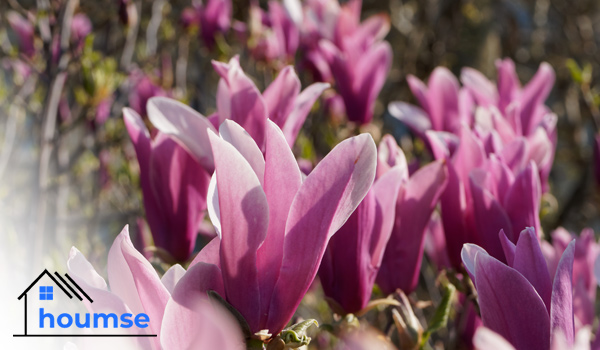
- Bloom Shade: Pink, reddish-purple
- Mature Shape: Large shrub or a small tree
- Mature Size: 8 to 12 feet tall, 8 to 12 feet wide
- Hardiness: 7 to 10
- Light: Full sun to partial shade
- Soil: Well-drained and moist acidic, loamy, sandy, and clay soils
Liliiflora is a fantastic dwarf pink magnolia tree with signature reddish-purple or pink flowers shaped like lilies. The flowers are lightly perfumed and when all are open, the dark green elliptical magnolia leaves unfurl.
It is interesting to note that this shrub is actually the saucer magnolia tree’s parent, and ‘Nigra’ is one of its favorite cultivars thanks to its deeply colored blossoms.
Sweetbay Magnolia Tree
- Bloom Shade: White
- Mature Shape: Large shrub or a small tree
- Mature Size: 10 to 20 feet tall, 10 to 20 feet wide
- Hardiness: 5 to 1016
- Light: Full sun to partial shade
- Soil: Well-drained and moist acidic, loamy, sandy, and clay soils
Because of its creamy white and their lemony fragrance, which appear in spring and summer, the M. virginiana is considered of the most exotic, attention-grabbing types of magnolia trees. The lovely blossoms turn into red fruits in the late summer and attract many birds.
As a compact tree, ‘Sweetbay’ has convenient care, makes no mess, and can be grown in narrow spaces or patios perfectly. It even tolerates periodic flooding.
- In this post:
- Types of Magnolia Trees
